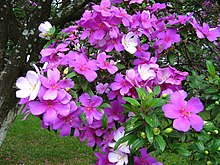| Pleroma mutabile | |
|---|---|

| |
| Flowers in different colours | |
| Scientific classification | |
| Kingdom: | Plantae |
| Clade: | Tracheophytes |
| Clade: | Angiosperms |
| Clade: | Eudicots |
| Clade: | Rosids |
| Order: | Myrtales |
| Family: | Melastomataceae |
| Genus: | Pleroma |
| Species: | P. mutabile |
| Binomial name | |
| Pleroma mutabile (Vell.) Triana | |
| Synonyms | |
| |
Pleroma mutabile, synonym Tibouchina mutabilis, is an evergreen pioneer tree with an open crown, native to the Brazilian Atlantic Forest, mainly at the Serra do Mar zone, in the states of São Paulo, Paraná, Rio de Janeiro, and Santa Catarina.
In Brazil, it is named manacá-da-serra. The word "manacá" means "flower" in Tupi-guarani language. "Serra" (ridge, in English) alludes to the Serra do Mar (Sea's Ridge).
In Australia, it is a popular ornamental plant, also known as glory bush.
Description
Pleroma mutabile can grow up to 12 metres in height. The short, slender bole can reach 14 inches in diameter.
The wood is sometimes harvested from the wild for furniture making. It is an ornamental tree with flowers in three colours. It is suitable for use in urban landscaping, since its roots do not affect nearby structures.
It is a very resistant tree and is suitable for container gardening. Although this tree can reach 12 meters in height, if kept in a container the pot limits the available space for its roots, which restricts the tree's growth.
This plant prefers full sun, but will tolerate a small amount of shade. Must be planted in well-drained soils, rich in organic matter.
Landscaping
Initially cultivated as an ornamental plant in the South and Southeast regions of Brazil, where it occurs naturally, it quickly became popular for landscaping all over the country. It is normally a recommended tree for urban areas, because its roots are not aggressive, thus they do not destroy sidewalks and walls. The tree's small or medium size does not affect the urban electrical wiring, either.
References
- ^ "Pleroma mutabile (Vell.) Triana". Plants of the World Online. Royal Botanic Gardens, Kew. Retrieved 2022-05-02.
- Guimarães, Paulo José Fernandes; Michelangeli, Fabián A.; Sosa, Karla; Santiago Gómez, Jesús Ricardo (2019). "Systematics of Tibouchina and allies (Melastomataceae: Melastomateae): A new taxonomic classification". Taxon. 68 (5): 49. doi:10.1002/tax.12151. ISSN 0040-0262. S2CID 213372275.
- Roskov Y.; Kunze T.; Orrell T.; Abucay L.; Paglinawan L.; Culham A.; Bailly N.; Kirk P.; Bourgoin T.; Baillargeon G.; Decock W.; De Wever A. (2014). Didžiulis V. (ed.). "Species 2000 & ITIS Catalogue of Life: 2014 Annual Checklist". Species 2000: Reading, UK. Retrieved 26 May 2014.
- Dias, Antônio Gonçalves. Diccionario da Lingua Tupy, chamada Lingua Geral dos Indigenas do Brazil. Lípsia: F.A. Brockhaus, 1858.
- ^ "Tibouchina Noelene".
- ^ Lorenzi, Harri: Árvores brasileiras: manual de identificação e cultivo de plantas arbóreas do Brasil, vol. 1. Instituto Plantarum, Nova Odessa, SP, 2002, ISBN 85-86714-16-X.
- "Does Keeping a Tree in a Small Pot Keep it from Growing Tall?".
- Terra da Gente (2017-01-06). "Manacá-da-serra, Tibouchina mutabilis". G1 (in Brazilian Portuguese). Archived from the original on 2021-07-26. Retrieved 2021-07-26.
External links
 Media related to Tibouchina mutabilis at Wikimedia Commons
Media related to Tibouchina mutabilis at Wikimedia Commons
| Taxon identifiers | |
|---|---|
| Pleroma mutabile | |
| Tibouchina mutabilis | |
This tree-related article is a stub. You can help Misplaced Pages by expanding it. |